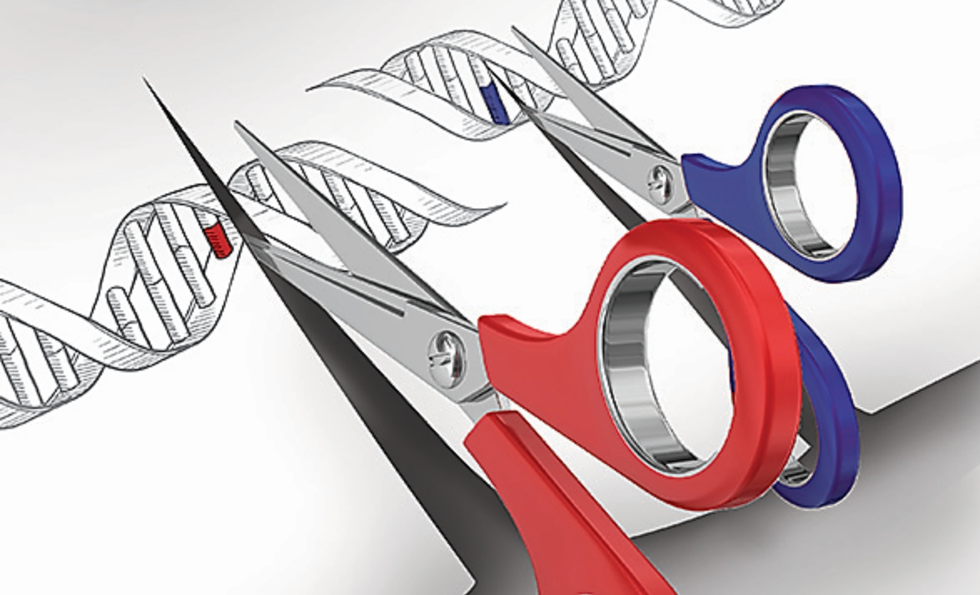CRISPR/Cas9 is a futuristic gene-editing technology that is either the key to a number of medical breakthroughs or a terrifying step toward an unnatural future of altered organisms. Possibly both. Regardless of what you think about genetic engineering, people are already using the tool to make changes to organisms that could revolutionize agriculture, lead to new treatments for diseases with no cure, or even modify human embryos.
There are multiple gene-editing "tools," but CRISPR is by far the most cost-effective and precise. It works by injecting a DNA construct with three major components into a living organism. The components are the Cas9 enzyme that cuts or deletes a segment of DNA, a sequence of RNA that guides the Cas9 to the correct location to cut, and a new DNA template to repair the cut with.
At the end of 2014, about 600 research papers had been published that mentioned CRISPR, and interest in the technology is only growing. Here are 11 things we could achieve with CRISPR—or already have.
1. Remove Malaria from Mosquitos
Researchers created mosquitos that are resistant to the parasite that causes malaria, Plasmodium falciparum. They used CRISPR to remove a segment of mosquito DNA, and when the mosquitos' genetic system tried to repair the genome, it was tricked into replacing it with a DNA construct engineered by the scientists. Two genes in the construct make the mosquitos resistant to Plasmodium falciparum. The altered mosquitos passed on the resistance genes to 99 percent of their offspring, even when they mated with normal mosquitos. Good news for beating back a horrible disease.
2. Eliminate a Patient's Cancer
This medical marvel actually wasn't achieved using CRISPR, but using a similar gene-editing tool called TALEN. An infant girl had lymphoblastic leukemia, a serious form of blood cancer. After trying traditional cancer-treating methods such as chemotherapy and bone-marrow transplants, the doctors decided to use gene-editing technologies in a last-ditch effort to save the girl. By altering the immune system T-cells of a donor to more effectively locate and kill leukemia cells without attacking the girl's body, doctors successfully eliminated her cancer.
3. Treat Muscular Dystrophy
Duchenne muscular dystrophy is caused by a mutation that prevents the body from producing the dystrophin protein, a critical protein in the development of muscle tissue. People who have this genetic mutation suffer from muscle degeneration that is ultimately fatal. Because the mutation that causes muscular dystrophy affects one specific gene, the disease is a prime target for using CRISPR/Cas9. Researchers successfully treated muscular dystrophy in lab mice this month by using CRISPR to cut and repair the dystrophin gene.
4. Make Hulked-Out Goats and Dogs
Chinese scientists have used CRISPR/Cas9 to delete genes that inhibit muscle and hair growth in goats to supplement the country's commercial meat and wool industries. They also did the same to a couple of beagles, for reasons that are not quite clear. China is aggressively researching both genetic engineering and cloning, and it's possible that these two technologies become a common method of expanding livestock and agricultural industries. Huge delicious cows that don't get sick rolling out of the cloning factory? It could happen.
5. Give Pig Organs to Humans
George Church of the Harvard Medical School recently led a team of scientists that used a complex CRISPR molecule to edit 62 genes in pig cells at once. Church believes that this technique could be used to make pig organs suitable for transplantation into humans. The team's experiments also represent a step forward in CRISPR technology by using the tool to edit many genes at once, a method that could be imitated to make more complicated changes to DNA quickly.
6. Treat HIV
HIV inserts its DNA into the genome of the host, and while it can lay dormant for years and certain drug cocktails can keep it in check, there is no way to make the virus permanently inactive. Researchers have demonstrated that CRISPR can be used to remove the virus's DNA from the patient's genome. The big problem is that it is difficult to locate HIV DNA in latent cells that don't demonstrate any of the symptoms associated with the active virus. More detailed models of latently infected cells are being developed in an attempt to find genetic sequences that could be cut out of the virus to render it harmless.
7. Develop New Kinds of Drugs
Drug companies are eager to invent new ways to deliver the CRISPR gene-editing system to different parts of the body. Pharmaceutical giant Bayer AG and startup CRISPR Therapeuticsrecently announced a $300 million joint venture to develop CRISPR-based drugs to treat heart disease, blood disorders, and blindness. The partnership represents not an impending cure for any one disease, but the beginning of a significant and aggressive period of research that they hope could lead to many.
8. Make Super Plants
Humans have been improving the yield and disease resistance of crops for hundreds of years through traditional agricultural methods. But now researchers are experimenting with ways to improve crop disease resistance and environmental stress tolerance using CRISPR. A research team from Rutgers is working on a long-term project to genetically modify wine grapes and turfgrass in such a way that the methods can be implemented in a variety of other crops. The grapes will be edited to resist downy mildew, and a type of grass commonly found on golf courses called creeping bentgrass will be modified to resist dollar spot disease, a problem that is usually combated with fungicides. If successful, scientists could develop new, heartier crops to supplement the agricultural industry.
9. Engineer Mini-Pigs
In another example of gene-editing using the tool TALEN, Chinese researchers created a particularly small variety of the Bama pig by disabling one of the growth hormone receptor genes within the pig's fetal cells. The little pigs will reach about 30 pounds when full-grown. The researchers plan to sell the "micropigs" as pets.
10. Treat Blindness
There are a few efforts to use CRISPR to treat or even cure blindness in humans. Researchers have successfully removed a genetic mutation from mice that causes retinitis pigmentosa, a disease that ultimately leads to blindness. After a single injection of the CRISPR/Cas9 system, the rats were able to see better than a control group. Plans to use a similar technique on humans are already underway. Biotechnology company Editas Medicine is planning to use CRISPR to treat the inherited eye disease leber's congenitial amaurosis (LCA) by 2017.
11. Edit Humans
Gene-editing techniques have already been used on humans, as is the case with the infant girl who was treated for leukemia with engineered T-cells. But scientists aren't likely to stop there. Researchers at the Francis Crick Institute in London want to genetically modify human embryos to learn more about the earliest stages of human life and potentially reduce the number of miscarriages. Experiment proposals like this one make some people worry that genetic engineering technologies will be used in the future to create "designer babies" with preferred traits. We are a far cry from that kind of experimentation, but it won't be long before gene-editing is used to combat diseases and other ailments.

Jay Bennett is the associate editor of PopularMechanics.com. He has also written for Smithsonian, Popular Science and Outside Magazine.













